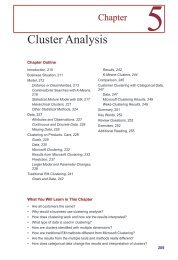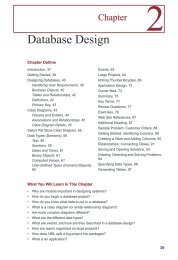Revision History - Jerry Post
Revision History - Jerry Post
Revision History - Jerry Post
You also want an ePaper? Increase the reach of your titles
YUMPU automatically turns print PDFs into web optimized ePapers that Google loves.
In 1990, Blockbuster planned to categorize its 30 million customers according to the<br />
types of movies they rented and to “sell information from the database ... to direct mailers,<br />
for planning target-marketing campaigns.” Blockbuster used sophisticated computer systems<br />
to keep records of each individual's transactions. The plans raised difficult privacy issues<br />
for the same reason it would prove to be a gold mine for direct mailers. Video choices<br />
are among the most revealing decisions a consumer makes [Wall Street Journal 1990].<br />
While a federal law forbids video stores from disclosing the names of the movies its customers<br />
rent, it does not forbid stores from telling direct marketers “the subject matter” of the<br />
movies a customer has rented. Blockbuster, whose members represent one out of six American<br />
households, says its database will be legal because it monitors video categories, not<br />
specific titles. In 1990, the chain organized its shelves by 37 categories, with plans to add<br />
30 to 40 more.<br />
Blockbuster ultimately implemented client-server, to recapture the major benefit offered<br />
by its legacy system, a consistent retail systems architecture. In 1994, Blockbuster<br />
acquired a music store business that ran different systems and had different requirements<br />
than its video stores. The music stores came with five different PC-based systems. Blockbuster<br />
Video wanted to get back to a single system for all its stores. To standardize its retail<br />
systems, Blockbuster worked with Microsoft and Oracle to build a Windows NT-based<br />
retail system to be implemented throughout its stores worldwide. As it migrated to clientserver,<br />
Blockbuster maintained its traditional host architecture. All processing occurs on<br />
the server; client computers are relatively dumb. Blockbuster was looking for other benefits<br />
from moving to client-server: reduced training; reduced support costs; and access to more<br />
advanced technologies, software, and graphical user interfaces.<br />
To further its ability to track its customers, Blockbuster tracks every single customer’s<br />
rental history, every single store’s daily business, and every single store item’s sales<br />
record. Data on more than 40 million customers gives Blockbuster an important source of<br />
information on consumer demographics and purchase decisions.<br />
With a consolidated database, Blockbuster turned to Hyperion’s Essbase analysis<br />
software. The company uses the tools to analyze things like the effects of weather on rentals<br />
and exploiting peak rental times. The company originally estimated that it could save<br />
$30 million in operational costs over the life of the project—largely by automating the data<br />
analysis [Songini 2001].<br />
In its quest to become the neighborhood entertainment source, Blockbuster uses its<br />
extensive consumer database to select the product mix. “The goal is neighborhood retailing<br />
and the customization of each product for each store,” says marketing manager, Baskin<br />
[Desjar, 2001]. “The key is to cater to the local market and service the local customer.”<br />
Baskin says the chain has the “strategic advantage” of knowing the entertainment buying<br />
habits of half of the households in the United States. Managers at individual locations will<br />
have the most input on which products to stock. “Having unmatched demographic information<br />
is a great guide, but it’s not a silver bullet,” says Baskin.<br />
Blockbuster tried to diversify by expanding into music stores. It even attempted to<br />
add book sales, tailoring the titles to specific locations. In 1999, after consistently losing<br />
money, Blockbuster sold all of the music stores.<br />
In 1999, Blockbuster outsourced the main order-management services for its website<br />
to OrderTrust [Bacheldor 1999]. The company provides the software and security to handle<br />
the sales transactions. It also provides links to multiple suppliers. Consequently, the<br />
30







